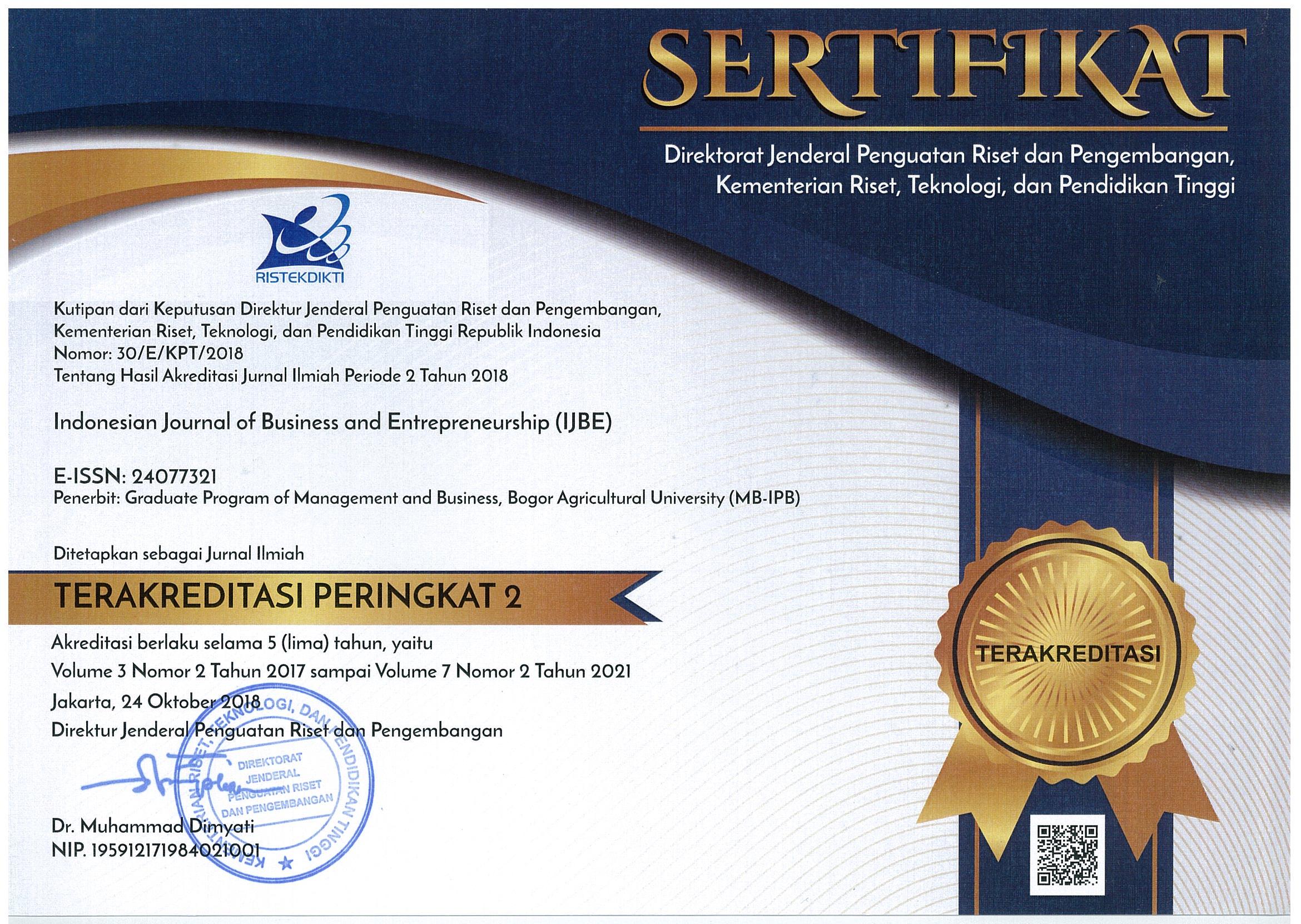THE EFFECT OF WORKING CAPITAL ON THE PROFITABILITY OF PALM OIL PLANTATION COMPANIES
Abstract
Management decisions related to working capital are based on the management of short-term assets and liabilities, aiming to ensure that the company is able to maintain the operations and have sufficient cash flows to finance short-term debt maturities and operational costs, as well as to improve the profitability of the company. The objective of this study is to examine the effect of working capital management on company profitability. Working capital is considered to be an important issue in financial management and have an effect on liquidity as well as on the company profitability. In addition, optimized working capital management contributes greatly to the achievement of company objectives. The secondary data were taken from the annual reports of 6 oil palm plantation companies registered in the Indonesia Stock Exchange (IDX) during the year 2009-2015. Profitability as a dependent variable was measured by return on investment (ROI). Cash conversion cycle (CCC), current ratio (CR), financial debt ratio (FDR), and fixed financial asset ratio (FFAR) are independent variables. The analytical model used in this study was panel regression by using Fixed Effect Model. The results showed that there is a negative effect of working capital on profitability. Profitability will increase as cash cycle conversion cycle decreases. This is because companies with short cash conversion cycle are able to collect the cash needed for the company's day-to-day operations.Keywords: working capital, cash conversion cycle, current ratio, debt ratio, fixed assets ratio. profitability
ABSTRAK
Keputusan manajemen yang berkaitan dengan modal kerja didasari oleh cara pengelolaan antara aset dan kewajiban jangka pendek, hal ini bertujuan untuk memastikan bahwa perusahaan mampu untuk melanjutkan kegiatan operasional dan memiliki arus kas yang cukup untuk membiayai hutang jangka pendek yang jatuh tempo dan biaya kegiatan operasional, serta untuk meningkatkan profitabilitas perusahaan. Tujuan dari makalah ini adalah menganalisis pengaruh manajemen modal kerja terhadap profitabilitas perusahaan. Modal kerja dianggap sebagai masalah yang penting dalam manajemen keuangan dan memiliki efek pada likuiditas serta pada profitabilitas perusahaan. Selain itu, manajemen modal kerja yang optimal memberikan kontribusi yang besar dalam pencapaian tujuan perusahaan. Penulis menggunakan data sekunder yang bersumber dari laporan tahunan 6 perusahaan perkebunan kelapa sawit yang terdaftar di Bursa Efek Indonesia (BEI) selama tahun 2009–2015. Profitabilitas sebagai variabel dependen diukur dengan return on investment (ROI).Cash conversion cycle (CCC), current ratio (CR), financial debt ratio (FDR), dan fixed financial asset ratio (FFAR) merupakan variabel independen. Model analisis yang digunakan adalah model regresi panel menggunakan Fixed Effect Model. Hasil penelitian menunjukkan bahwa ada pengaruh negatif dari modal kerja terhadap profitabilitas. Profitabilitas akan bertambah saat waktu siklus konversi kas berkurang. Hal ini dikarenakan perusahaan yang memiliki waktu siklus konversi kas yang pendek mampu mengumpulkan kas yang diperlukan untuk operasional sehari-hari perusahaan.
Kata kunci: modal kerja, siklus konversi kas, rasio lancar, rasio hutang, rasio aktiva tetap profitabilitas
Downloads
References
Afza T, Nazir MS. 2008. Working capital approaches and firms’ returns in Pakistan. Pakistan Journal of Commerce and Social Sciences 1(1): 25–36.
Ang R. 1997. Buku Pintar Pasar Modal Indonesia. Jakarta: Penerbit Media Staff Indonesia.
Brigham E, Joel FH. 2011. Dasar-Dasar Manajemen Keuangan. Jilid ke-2. Ed ke-10. Jakarta: Penerbit Salemba Empat.
Chowdhury A, Amin MM. 2007. Working capital management practices in pharmaceutical companies listed in Dhaka Stock Exchange. BRAC University Journal 4(2): 75–86.
Jain NK. 2004. Working Capital Management. New Delhi: Ashish Publicing House.
Lazaridis I, Tryfonidis D. 2006. Relationship between working capital management and profitability of companies listed in the Athens Stock Exchange. Financial Management and Analysis 19(1): 26–35.
Margaretha F, Nina A. 2008. Pengaruh working capital, fixed financial asset, financial debt, dan firm size terhadap profitabilitas. Jurnal Informasi, Perpajakan, Akuntansi dan Keuangan Publik. 3(1):29–43.
Mukhopadhyay D. 2004. Working capital management in heavy engineering firms-a case study. http://www.myicwai.com/knowledgebank/fm48.[23 Feb 2015].
Nazir MS, Afza T. 2009. Working capital requirements and the determining factors in Pakistan. The IUP Journal of Applied Finance 15(4): 28–39.
Raheman A, Afza T, Qayyum A. 2011. Sector-wise performance of working capital management measures and profitability using ratio analysis. Interdisciplinary Journal of Contemporary Research in Business 3(8): 285–303.
Raheman A, Afza T, Qayyum A, Bodla MA. 2010. Working capital management and corporate performance of manufacturing sector in Pakistan. International Research Journal of Finance and Economics (47): 151–163.
Ray S. 2012. Evaluating the impact of working capital management components on corporate profitability: evidence from Indian manufacturing firms. International Journal of Economic Practices and Theories 2(3):127–136.
Rifai N. 2009. Analisis financial distress dan kebutuhan modal kerja PT. Liza Herbal International [tesis]. Bogor: Institut Pertanian Bogor.
Valentina AH. 2014. Analisis manajemen modal kerja dan dampaknya terhadap profitabilitas dan nilai perusahaan (studi kasus pada industri logam di BEI) [tesis]. Bogor: Institut Pertanian Bogor.
Wang YJ. 2002. Liquidity management, operating performance, and corporate value: evidence from Japan and Taiwan. Journal of Multinational Financial Management 12: 159–169. https://doi.org/10.1016/S1042-444X(01)00047-0.
Yuliati NW. 2013. Pengaruh kebijakan modal kerja terhadap profitabilitas pada perusahaan hotel dan restoran di Bursa Efek Indonesia [tesis]. Bali: Universitas Udayana.








